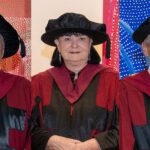Curtin University architecture students will design a new base for Nowanup Bush University, an important meeting place for Nyungar people located 50 kilometres west of Bremer Bay.
The bush university concept, initiated by Professor Simon Forrest from Curtin University, Nowanup Nyungar Elder Mr Eugene Eades and Gondwana Link CEO Mr Keith Bradby, aims to provide a bush setting for transformational learning.
Curtin University’s Elder-in-Residence Professor Simon Forrest said the project offered a unique opportunity for five groups of Curtin University architecture students to each work with an architecture firm to create a new design and model for the facilities at Nowanup.
“We are always looking for innovative ways to educate students and this project will allow students to learn in an unusual and significant setting, surrounded by Indigenous culture and history,” Professor Forrest said.
“Once the suggested designs are submitted by the five student groups, the most appropriate design will be selected and the winning designs will be announced in April 2018.
“The project has a range of potential collaborations for student groups across the University, which will initially begin with the architecture students, and may see engineering students involved in site works and other aspects of the facility.”
Once the building works are completed, Nowanup Bush University will incorporate various programs for university students, school groups, and community groups to interact and learn in an environment that is delivered in and from a Nyungar point of view and principles.
Under Mr Eades’ leadership, Nowanup has been used as a cultural knowledge camp as an alternative to detention for young Indigenous people since 2009.
The 750 ha Nowanup property was one of the first purchased to help achieve the Gondwana Link project, which aims to reconnect native habitats across the South-West of Western Australia.
Gondwana Link is considered one of the largest and most ambitious conservation projects in Australia’s history, with its goal to restore 1,000 kilometres of continuous habitat.


